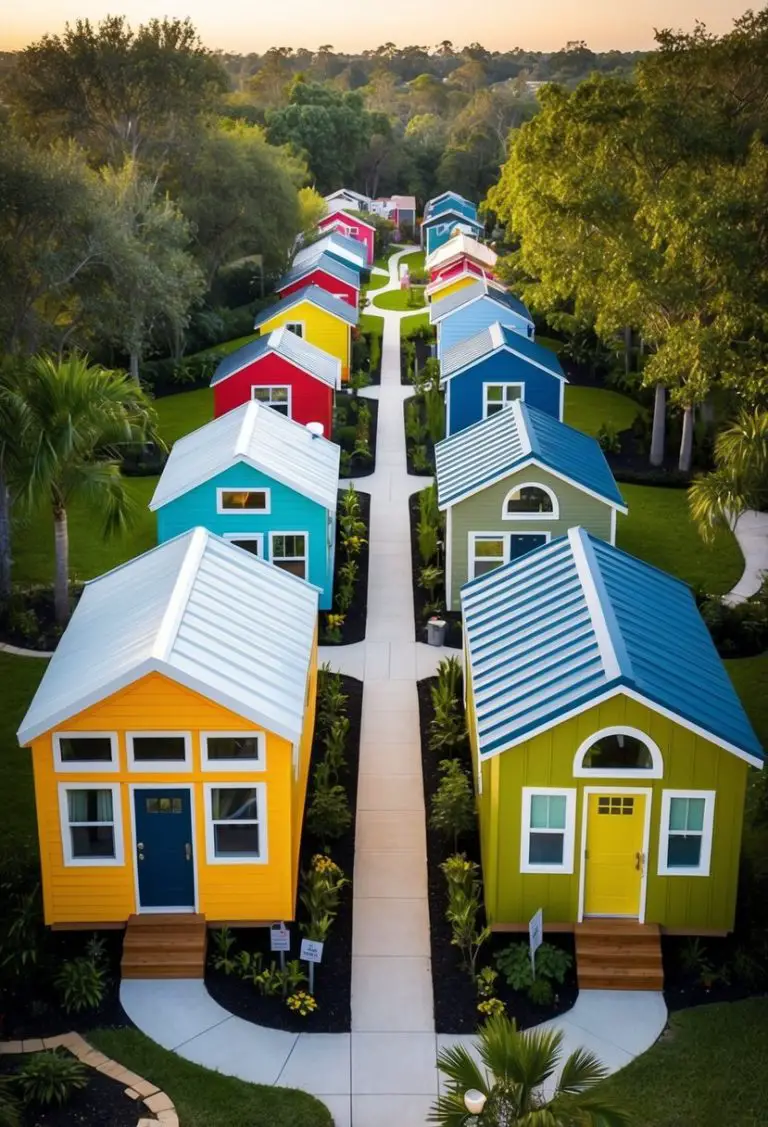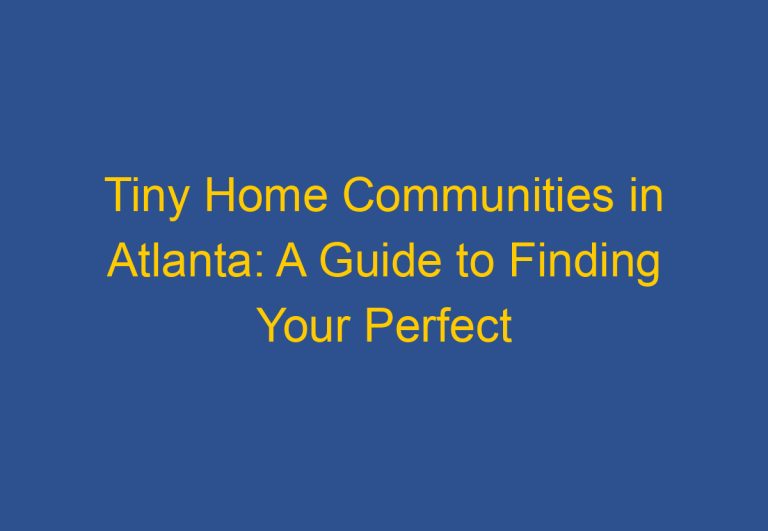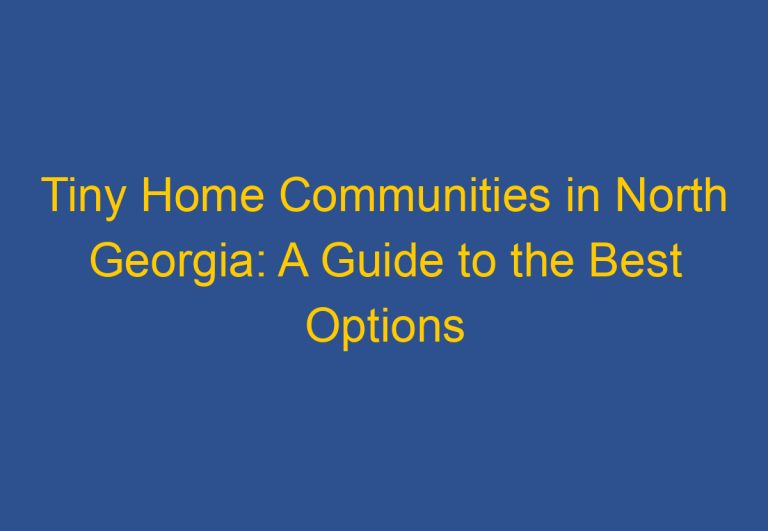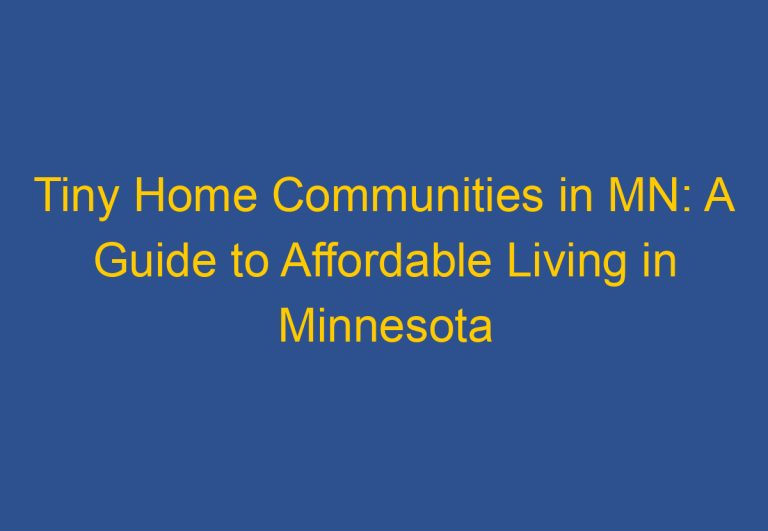Tiny Home Communities in Utah: A Guide to Affordable Living Options
Utah is a state known for its picturesque landscapes and outdoor recreational opportunities. In recent years, it has also become a popular destination for those seeking a minimalist lifestyle in the form of tiny homes. These small, often mobile dwellings offer a simpler way of living, and many people are choosing to join tiny home communities in Utah to share this lifestyle with others.
Tiny home communities in Utah are growing in popularity, and there are now several options to choose from across the state. Some communities are geared towards retirees or those seeking a vacation home, while others are more focused on sustainable living and off-grid lifestyles. Many communities offer shared amenities such as gardens, community centers, and even workshops for building and maintaining tiny homes.
For those interested in building their own tiny home, Utah is home to several tiny house builders who can help make that dream a reality. These builders offer customizable designs and a range of price points to fit different budgets. Additionally, Utah has established regulations for tiny homes, including minimum square footage requirements and ceiling height restrictions, making it a feasible option for those looking to downsize and simplify their lives.
Benefits of Tiny Home Living in Utah
Living in a tiny home community in Utah has many benefits. In this section, we will discuss some of the advantages of tiny home living in Utah, including affordability and cost savings, proximity to nature and national parks, and community and lifestyle.
Affordability and Cost Savings
Tiny homes are known for their affordability and cost savings. They are a great option for those who want to live a self-sufficient lifestyle and save money. In Utah, tiny homes are a popular choice for families who want to downsize and reduce their living expenses.
Compared to traditional homes, tiny homes have lower utility bills, lower property taxes, and lower maintenance costs. They are also easier to clean and maintain, which can save homeowners time and money in the long run.
Proximity to Nature and National Parks
Utah is known for its stunning natural beauty and national parks. Living in a tiny home community in Utah allows residents to be closer to nature and enjoy the great outdoors. Utah has many national parks, including Zion National Park, Bryce Canyon National Park, and Arches National Park, which are all within driving distance of many tiny home communities.
Living in a tiny home community also allows residents to reduce their carbon footprint and live a more sustainable lifestyle. Many tiny homes are built with eco-friendly materials and are designed to be energy-efficient.
Community and Lifestyle
Living in a tiny home community in Utah allows residents to be part of a close-knit community. Tiny home communities often have shared spaces and amenities, such as community gardens, playgrounds, and common areas, which allow residents to socialize and build relationships with their neighbors.
Many tiny home communities also offer a unique lifestyle, with a focus on simplicity, minimalism, and living with less. This lifestyle can be appealing for those who want to reduce their environmental impact, simplify their lives, and focus on what really matters.
In conclusion, living in a tiny home community in Utah has many benefits, including affordability and cost savings, proximity to nature and national parks, and community and lifestyle. If you are looking for a unique and sustainable living option in Utah, a tiny home community may be the perfect choice for you.
Legal and Practical Considerations
Zoning Laws and Building Codes
When it comes to building tiny home communities in Utah, it is essential to follow the zoning laws and building codes. Each county and city in Utah has its own set of zoning laws and building codes that must be adhered to. For example, Wasatch County allows tiny homes to be built on agricultural land if they meet the county’s building codes. In Provo, tiny homes are allowed as accessory dwelling units (ADUs) on residential lots if they meet the city’s building codes. In St. George, tiny homes must be built on a foundation and meet the International Residential Code (IRC) requirements.
To ensure compliance with local zoning laws and building codes, it is recommended to obtain the necessary permits before starting any construction. This may include building permits, plumbing permits, electrical permits, and sewer permits. It is important to note that failure to obtain the necessary permits can result in fines and legal issues.
Utilities and Services
When building a tiny home community in Utah, it is important to consider utilities and services. This includes access to sewer, electric, and water. In some cases, it may be necessary to install a septic system or well to provide these services. It is important to research the local regulations and requirements for these services before beginning construction.
In addition to basic utilities, it is also important to consider other services such as waste management and internet access. Many tiny home communities in Utah have found creative solutions to these issues, such as composting toilets and shared internet services.
Location and Accessibility
The location of a tiny home community in Utah can greatly impact its success. Factors such as accessibility to public transportation, proximity to amenities such as grocery stores and healthcare facilities, and the overall safety of the area should be considered. Additionally, it is important to ensure that the location of the community is zoned for residential use and meets all local zoning laws and building codes.
Overall, building a tiny home community in Utah requires careful planning and consideration of legal and practical issues. By following local zoning laws and building codes, obtaining necessary permits, ensuring access to utilities and services, and carefully selecting a location, a successful and thriving tiny home community can be created.
Frequently Asked Questions
What are the zoning regulations for tiny home communities in Utah?
In Utah, zoning regulations for tiny home communities vary depending on the county and city. However, most counties require that tiny homes be built on a permanent foundation and meet certain minimum square footage requirements. For example, in Salt Lake County, tiny homes must be at least 400 square feet. It is important to research the specific zoning regulations for the area where you plan to build or purchase a tiny home.
How does the cost of living in a Utah tiny home community compare to traditional housing?
The cost of living in a Utah tiny home community can vary depending on the location, amenities, and size of the home. However, in general, living in a tiny home community can be more affordable than traditional housing. Tiny homes typically have lower utility costs and require less maintenance, which can help residents save money in the long run.
What amenities are typically offered in luxury tiny home communities in Utah?
Luxury tiny home communities in Utah may offer a range of amenities, including community gardens, fitness centers, swimming pools, and outdoor recreational areas. Some communities may also offer concierge services, laundry facilities, and pet-friendly areas. It is important to research the specific amenities offered by each community before making a decision.
Are there any tiny home communities in Utah that offer homes for rent?
Yes, there are several tiny home communities in Utah that offer homes for rent. Renting a tiny home can be a great option for those who want to experience tiny home living without committing to a long-term purchase. It is important to research the rental terms and requirements for each community before making a decision.
What is the process for purchasing a tiny home in a Utah community?
The process for purchasing a tiny home in a Utah community can vary depending on the community and the builder. Some communities may have pre-built homes available for purchase, while others may require residents to work with a builder to design and construct their home. It is important to research the purchasing process for each community before making a decision.
How do tiny home communities near Salt Lake City cater to residents’ needs?
Tiny home communities near Salt Lake City may offer a range of services and amenities to cater to residents’ needs. For example, some communities may offer shuttle services to nearby attractions and shopping centers, while others may have on-site maintenance and repair services. It is important to research the specific services offered by each community before making a decision.










